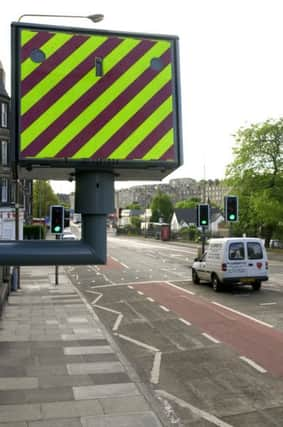Fears over '˜death formula' used by Edinburgh Council for speed cameras


It was asked again last week in the wake of the horrific fatal crash on Maybury Road, as residents voiced fears about the risk of further accidents on a “very bad stretch of road”.
Jonathan Smith died after his car burst into flames in a crash caused by a speeding stolen car. Five years earlier Billy Casement was killed on the same stretch of road as he was being driven in a friend’s car at 74mph in the 40mph zone.
Advertisement
Hide AdAdvertisement
Hide AdBut chillingly there is an answer to the question about how many deaths are needed before action is taken – it’s three.
Speed cameras are installed according to a formula which gives points for accidents according to their seriousness – three points for a fatal collision, two for a serious collision and one point for a slight collision. Seven points are needed for a site to be considered for a camera. And the accidents must happen within a three-year period and a one-kilometre stretch.
Edinburgh Western Liberal Democrat MSP Alex Cole-Hamilton said he was “sickened” when he learned the formula meant three people would need to be killed before any action.
“Try telling that to the residents of Ratho Station who live along the Glasgow Road and have seen neighbours killed on the road, but not within a recent enough timeframe for it to count towards their seven points; or to those living on Silverknowes Road, where speeding motorcycles have already claimed one young life, but bring the area only a third of the way to the council’s threshold; or to the residents of Lennie Cottages on Craigs Road who, living beside the airport, suffer speeding freight trucks and have a rapidly growing pet cemetery out back and fear, not unreasonably, for their children.
“I understand money is tight, but I cannot accept we are waiting for residents to die before the city acts on these well-known hotspots.
“I understand speed cameras cost a lot of money but weigh that against the potentially devastating loss of life that not bringing some sort of solution to these areas would have.
“We talk about prevention in nearly all aspects of public policy from health to criminal justice. I cannot accept we run a policy of failure demand in transport which is literally waiting for people to die.”
At Lennie Cottages, nurse Claire Smith, who has lived there for over 20 years, said speeding traffic was a persistent problem. She has had three cats run over.
Advertisement
Hide AdAdvertisement
Hide Ad“Drivers often take a run up the hill – rather than slowing up, they are putting their foot down. Thank goodness we’ve not had anyone killed or knocked down. But there must have been about ten cats from these cottages run over in the time I’ve been here.”
She said the number of trucks from the airport coming past the houses had reduced in the last two years but the problem of speeding traffic had not disappeared.
Another resident, Graham Telfer, said: “It’s meant to be a 30mph limit, but a neighbour had an app on his phone and 85 per cent of people were breaking the speed limit.”
Tragedy struck in Silverknowes Road in June 2016 when 14-year-old Brad Williamson was killed falling from a stolen motorbike when it collided with a car.
The area has been plagued by joyriders, with residents complaining about youngsters speeding up and down on the bikes.
A public meeting is being held in South Queensferry later this week amid concerns about a lot of near misses on Bo’ness Road, close to Echline Primary School, where traffic is said to go at up to 70mph in a 30mph limit.
Mr Cole-Hamilton said: “One neighbour who lost a friend at the age of eight in a road accident when she was at school, said she was terrified the same thing was going to happen to someone else.”
The city council said the criteria for installing speed cameras were set nationally and the cameras were provided, maintained and operated by Police Scotland’s Scottish Safety Camera Programme (SSCP).
Advertisement
Hide AdAdvertisement
Hide AdTransport convener Councillor Lesley Macinnes said: “The council assists the SSCP in their annual assessment of potential sites for speed or red light cameras, which is an evidence-led process using nationally set criteria based on things like collision data.
“We take residents’ concerns about individual streets extremely seriously. However cameras are not the only solution for addressing road safety issues. Our experienced road safety team takes a number of factors into consideration when prioritising road safety interventions.
“I’m looking forward to meeting the local community to discuss issues around Bo’ness Road later this week.”
Andrew Jones, manager of the SSCP’s East Safety Camera Unit, said cameras played a pivotal role in improving driver behaviour.
“The Road Safety Framework to 2020 sets out a collaborative approach towards an ultimate vision of zero fatalities and casualty reduction is a top priority.
“The SSCP aims to reduce the number of casualties on Scotland’s roads by encouraging improved driver behaviour.
“All sites that demonstrate a collision and speed history are regularly assessed and prioritised. Safety cameras are targeted at areas most in need in terms of road casualty reduction and deployed where they have the greatest casualty and collision reduction potential.
“To improve operational effectiveness and deployment flexibility there is scope within the programme to carry out short term mobile deployments. These however have to be evidence led.
Advertisement
Hide AdAdvertisement
Hide Ad“Given that safety cameras are only one of many tactical options, care has to be taken to deploy them where there is sufficient evidence of road casualties where their use can mitigate future risk. To achieve this, we work with partners to ensure that collectively we deploy the correct solution to any identified location.”